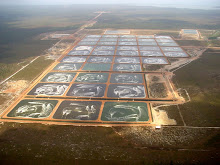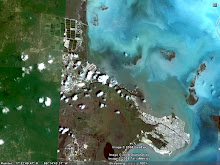
The meeting in Independence went quite well yesterday. Over 60 students from 1-4 forms (Middle School through High School age) attended. The level of interest was high. We'll have a follow-up meeting in about 10 days to set up Google accounts and begin posting. I noticed a big uptick in the web site hits from Belize, so some students are obviously already checking out the site.
In addition to the meeting at Independence, I also was able to meet with local shrimp farmers and get their input on the project. The reception among the shrimp farmers to our project has been very positive here.
 One of those farms is allowing us to use their AquaMats for the substrate experiments this spring. For anyone who is wondering, here is a shot of the AquMats we'll be using to test the substrate mitigations this spring. As you can see, there's no lack of material here. Your experiments are starting on a small scale (as is appropriate), but when they are fully developed you'll be dealing with quantities of material like this.
One of those farms is allowing us to use their AquaMats for the substrate experiments this spring. For anyone who is wondering, here is a shot of the AquMats we'll be using to test the substrate mitigations this spring. As you can see, there's no lack of material here. Your experiments are starting on a small scale (as is appropriate), but when they are fully developed you'll be dealing with quantities of material like this.
 One of those farms is allowing us to use their AquaMats for the substrate experiments this spring. For anyone who is wondering, here is a shot of the AquMats we'll be using to test the substrate mitigations this spring. As you can see, there's no lack of material here. Your experiments are starting on a small scale (as is appropriate), but when they are fully developed you'll be dealing with quantities of material like this.
One of those farms is allowing us to use their AquaMats for the substrate experiments this spring. For anyone who is wondering, here is a shot of the AquMats we'll be using to test the substrate mitigations this spring. As you can see, there's no lack of material here. Your experiments are starting on a small scale (as is appropriate), but when they are fully developed you'll be dealing with quantities of material like this.



That is so good! I will be very exited to talk to people there, and hear their input.
ReplyDeleteThe aquamat material seems very wispy. Is that so? What is their texture like?
We'll probably be online with the students in about 10 days to 2 weeks.
ReplyDeleteThe shape of the Aquamats is cut into strips to simulate seagrass, but the texture is tough and durable like a door mat. One side is woven tightly and one side is more loose and fibrous. The material is polyethylene and they are UV resistant so the sun won't weaken them quickly.
Alright, a texture like a door mat would seem alright. If they are built for growing organisms on them it would remove the question of what organisms will grow on materials and all that entailed. On the aquamat website it said it took 2 hours to clean the aquamats and I assume that is why they are not efficient enough. If this is the case, is it a requirement for them to be cleaned with bleach, if we were to use the stripping method for cleaning them?
ReplyDeleteI recently received a large amount of literature about Aquamats. I'll post them soon. Aquamats do require some cleaning, but apparently not all the users clean them between uses. I also found out that a 12 day "culturing period" is recommended before placing them in shrimp ponds. I'm in Honduras this week to give a talk at a WWF event. Hopefully I can get some time tonight to post more.
ReplyDelete